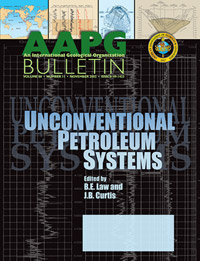Basin-centered gas
| Basin-centered gas systems | |

| |
| Series | AAPG Bulletin, November 2002 |
|---|---|
| Author | Ben E. Law |
| Link | Web page |
Basin-centered gas accumulations (BCGAs) are typically characterized by regionally pervasive accumulations that are gas saturated, abnormally pressured, commonly lack a downdip water contact, and have low-permeability reservoirs. The accumulations range from single, isolated reservoirs a few feet thick to multiple, stacked reservoirs several thousand feet thick.
Basin-centered gas systems (BCGSs) are potentially one of the more economically important unconventional gas systems in the world; in the United States they contribute as much as 15% of the total annual gas production. These regionally pervasive gas accumulations are different from conventionally trapped accumulations in several respects. Two types of BCGSs are recognized; a direct type, characterized by having gas-prone source rocks, and an indirect type, characterized by having liquid-prone source rocks. During the burial and thermal histories of these systems, the source rock differences between the two types of BCGSs result in strikingly different characteristics that impact exploration strategies. The majority of known BCGAs are the direct type.
Exploration activity for BCGAs is in the early stages and thus far has been focused in North America. In other parts of the world, concepts of basin-centered gas systems are poorly known, and exploration activity focused on basin-centered gas accumulations is minimal.
The global distribution of gas is not uniform. Some regions, like Russia and the Middle East, have extremely large gas resources to meet their energy demands, whereas other regions, like Japan and Western Europe, have limited amounts of gas and must rely on importing gas to meet their energy demands.[1] The increasing demand for energy in many parts of the world has made it imperative to explore for and exploit unconventional oil and gas resources, such as the BCGAs.
The BCGAs constitute a realistic, near-term energy resource that has only recently been the focus of exploration. However, with few exceptions, there is a generally poor understanding of BCGAs. Consequently, exploration efforts for this huge gas resource are not as effective as they might be. To develop more effective exploration strategies for BCGAs, it is necessary to modify traditional concepts of petroleum systems and include concepts of nontraditional, unconventional petroleum systems.
References
- ↑ U.S, Department of Energy, Energy Information Agency, 2002, International energy outlook 2002: DOE/EIA-0484, 21 p.
See also
- Basin-centered gas systems
- Basin-centered gas systems: historical development and classification
- Basin-centered gas systems: development
- Basin-centered gas systems: elements and processes
- Basin-centered gas systems: examples
- Basin-centered gas systems: gas resources
- Basin-centered gas systems: global distribution
- Basin-centered gas systems: evaluation and exploration strategies
- Tight gas reservoirs: evaluation